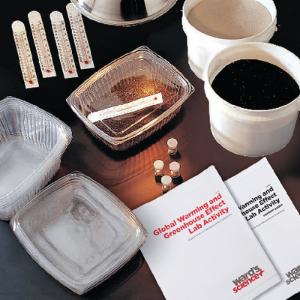Heat Things Up with this Greenhouse Effect Activity
Elementary School/Middle School
"I'm melting, melting. Ohhhhh, what a world, what a world!" (said in the sinister witch voice).
Ok, it was actually water that melted the wicked witch, but who among us hasn't cried out the same way during a blistering heatwave?
If your students aren't yet familiar with the greenhouse effect, don't sweat it, we've got you covered. In this simple activity from Boys’ Life, students can use common household supplies to simulate the greenhouse effect.
Maybe someday the future scientists and engineers in your classroom will help work to reduce greenhouse gases. Some of your future engineers could re-design vehicles and factories to reduce emissions. Others may work to change manufacturing processes, regulations, and practices to help clean up chemical sources of these gases.
How do greenhouse gases work?
French scholar, Joseph Fourier, first proposed the greenhouse effect in 1824. The greenhouse effect is a warming of Earth's surface and the air above it. It is originated by gases in the atmosphere which trap energy from the Sun—just like the glass in a greenhouse. These gases are called greenhouse gases (GHGs). These gases are water vapor (the most important), ozone, carbon dioxide, methane, and nitrous oxide, all of which are naturally present in the atmosphere. Some GHGs such as Chlorofluorocarbons (CFCs) are synthetic chemicals while others such as nitrogen oxides (NOx) result from burning fuel.
Sun rays enter the Earth's atmosphere passing through the layer of greenhouse gases. The Earth's surface consumes energy from the Sun. This energy is sent back into the atmosphere. Some part of this energy passes back into space, but most of it stays trapped in the atmosphere by the greenhouse gases causing our world to get the heat we need to survive. Ideally, the natural process is a properly maintained balance of energy and heat in the environment.
Can the greenhouse effect be harmful?
In general, the greenhouse effect is a good thing. The natural greenhouse effect has resulted in the very livable planet we call home. Without the natural greenhouse effect, Earth would be too cold for life to exist, it would be a solid ball of rock and ice—dropping from 14°C (57°F) to as low as minus 18°C (-0.4°F).
With too much greenhouse effect, it would be way too hot—a temperature rise of just a few °C would make parts of the planet too hot for humans to survive.
We have to make like Goldilocks and root for the sweet spot.
Unfortunately, the natural greenhouse process is being disrupted by pollution, cutting trees, burning fuels, and other human activities. These human activities add extra greenhouse gases to the atmosphere. As the level of these gases rises, so does the temperature of the Earth; we call this global warming.
How can we help reduce global warming?
An easy way we all can help reduce the harmful greenhouse gases is to reduce, reuse, and recycle. By recycling half of our household waste, we can save about 2,500 pounds of carbon dioxide annually. We can buy energy-efficient products that use far less energy than standard products. Even planting a tree helps because trees absorb carbon dioxide and give off oxygen. We can use less heat and air conditioning—that saves money too! We can also drive less and drive smart to avoid pollution—hey, it’s cool to carpool and save fuel.
The greenhouse effect is a very natural and important process. Global environmental change is one of the most important issues of our time. The students in your classroom can become the next generation of motivated young scientists and engineers who help us understand how we can stay warm, but not too warm. Get them started with this activity from Boys Life:
THE GREENHOUSE EFFECT
Materials:
- Tall plastic soda bottle
- Glass jar small enough to fit inside the bottle
- Scissors
- Thermometer
Steps:
- Use the scissors to cut the bottom off the plastic bottle. Remove the label, but leave the top on.
- Stand the thermometer inside a jar, place it in a sunny spot, and check the temperature in an hour.
- Put the bottle over the jar and leave it for another hour. Check its temperature, and compare with the earlier temperature.
Conclusion:
The second temperature is considerably warmer than the first. That’s because the solar energy passing into the bottle has been turned into heat that can’t escape. The earth’s atmosphere serves a similar function as the bottle — it allows the sun’s energy to pass through, then keeps it from escaping into space.
Recommended Products:
[StartProductBlock]

Global Warming and The Greenhouse Effect Lab Activity
Helps students investigate the effect of different surfaces on heat absorption and greenhouse gases and suggests ways to reduce the greenhouse effect on our planet. It allows students to explore NGSS Earth/Life Science DCIs ESS2, ESS3, LS1, and LS4...
[EndProductBlock]
[StartProductBlock]

Terrarium Thermometer
This wide range, horizontal terrarium/vivarium thermometer provides temperature readings from 60–107°F and 20–42°C. Size: 13.3cm.
[EndProductBlock]
[StartProductBlock]

Show Me Science: Understanding The Greenhouse Effect Video
Now available as a digital download. Students learn about the greenhouse effect, its causes, its effects on global warming, and what scientists are doing about it. Includes animation and time-lapse photography, as well as suggestions for careers in this field of study.
[EndProductBlock]
